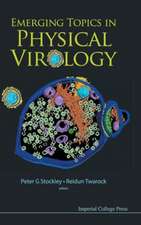Viral Vectors for Gene Therapy: Methods and Protocols: Methods in Molecular Medicine, cartea 76
Editat de Curtis A. Machidaen Limba Engleză Paperback – 9 noi 2010
| Toate formatele și edițiile | Preț | Express |
|---|---|---|
| Paperback (1) | 1111.26 lei 6-8 săpt. | |
| Humana Press Inc. – 9 noi 2010 | 1111.26 lei 6-8 săpt. | |
| Hardback (1) | 1114.71 lei 6-8 săpt. | |
| Humana Press Inc. – 7 oct 2002 | 1114.71 lei 6-8 săpt. |
Din seria Methods in Molecular Medicine
- 5%
 Preț: 1278.74 lei
Preț: 1278.74 lei - 15%
 Preț: 655.78 lei
Preț: 655.78 lei - 5%
 Preț: 1106.50 lei
Preț: 1106.50 lei - 5%
 Preț: 727.44 lei
Preț: 727.44 lei - 5%
 Preț: 1108.72 lei
Preț: 1108.72 lei - 15%
 Preț: 650.55 lei
Preț: 650.55 lei - 5%
 Preț: 735.66 lei
Preț: 735.66 lei - 18%
 Preț: 947.35 lei
Preț: 947.35 lei - 18%
 Preț: 948.92 lei
Preț: 948.92 lei - 5%
 Preț: 1114.54 lei
Preț: 1114.54 lei - 5%
 Preț: 1114.91 lei
Preț: 1114.91 lei - 15%
 Preț: 658.55 lei
Preț: 658.55 lei - 5%
 Preț: 734.01 lei
Preț: 734.01 lei - 5%
 Preț: 1111.61 lei
Preț: 1111.61 lei - 5%
 Preț: 1104.32 lei
Preț: 1104.32 lei - 5%
 Preț: 723.21 lei
Preț: 723.21 lei - 5%
 Preț: 1106.13 lei
Preț: 1106.13 lei - 5%
 Preț: 723.05 lei
Preț: 723.05 lei - 5%
 Preț: 1108.35 lei
Preț: 1108.35 lei - 5%
 Preț: 723.42 lei
Preț: 723.42 lei - 5%
 Preț: 1115.65 lei
Preț: 1115.65 lei - 5%
 Preț: 786.86 lei
Preț: 786.86 lei - 5%
 Preț: 1133.01 lei
Preț: 1133.01 lei - 5%
 Preț: 1114.71 lei
Preț: 1114.71 lei
Preț: 1111.26 lei
Preț vechi: 1169.74 lei
-5% Nou
Puncte Express: 1667
Preț estimativ în valută:
212.67€ • 221.21$ • 175.57£
212.67€ • 221.21$ • 175.57£
Carte tipărită la comandă
Livrare economică 15-29 aprilie
Preluare comenzi: 021 569.72.76
Specificații
ISBN-13: 9781617373084
ISBN-10: 1617373087
Pagini: 608
Ilustrații: XVI, 592 p.
Dimensiuni: 152 x 229 x 36 mm
Greutate: 0.84 kg
Ediția:Softcover reprint of hardcover 1st ed. 2003
Editura: Humana Press Inc.
Colecția Humana
Seria Methods in Molecular Medicine
Locul publicării:Totowa, NJ, United States
ISBN-10: 1617373087
Pagini: 608
Ilustrații: XVI, 592 p.
Dimensiuni: 152 x 229 x 36 mm
Greutate: 0.84 kg
Ediția:Softcover reprint of hardcover 1st ed. 2003
Editura: Humana Press Inc.
Colecția Humana
Seria Methods in Molecular Medicine
Locul publicării:Totowa, NJ, United States
Public țintă
Professional/practitionerCuprins
Use of the Herpes Simplex Viral Genome to Construct Gene Therapy Vectors.- Construction of Multiply Disabled Herpes Simplex Viral Vectors for Gene Delivery to the Nervous System.- Improved HSV-1 Amplicon Packaging System Using ICP27-Deleted, Oversized HSV-1 BAC DNA.- Herpes Simplex Amplicon Vectors.- Strategies to Adapt Adenoviral Vectors for Targeted Delivery.- Use of Recombinant Adenovirus for Gene Transfer into the Rat Brain.- Generation of Adenovirus Vectors Devoid of All Viral Genes by Recombination Between Inverted Repeats.- Packaging Cell Lines for Generating Replication-Defective and Gutted Adenoviral Vectors.- Improving the Transcriptional Regulation of Genes Delivered by Adenovirus Vectors.- Targeted Integration by Adeno-Associated Virus.- Development and Optimization of Adeno-Associated Virus Vector Transfer into the Central Nervous System.- A Method for Helper Virus-Free Production of Adeno-Associated Virus Vectors.- Novel Tools for Production and Purification of Recombinant Adeno-Associated Viral Vectors.- Recombinant Adeno-Associated Viral Vector Types 4 and 5.- Trans-Splicing Vectors Expand the Packaging Limits of Adeno-Associated Virus for Gene Therapy Applications.- Generation of Retroviral Packaging and Producer Cell Lines for Large-Scale Vector Production with Improved Safety and Titer.- An Ecdysone-Inducible Expression System for Use with Retroviruses.- In Vivo Infection of Mice by Replication-Competent MLV-Based Retroviral Vectors.- Development of Simian Retroviral Vectors for Gene Delivery.- Self-Inactivating Lentiviral Vectors and a Sensitive Cre-loxP Reporter System.- Lentiviral Vectors for Gene Transfer to the Central Nervous System.- A Highly Efficient Gene Delivery System Derived from Feline Immunodeficiency Virus (FIV).- A Multigene Lentiviral Vector System Based on Differential Splicing.- Production of Trans-Lentiviral Vector with Predictable Safety.- Human Immunodeficiency Virus Type 1-Based Vectors for Gene Delivery to Human Hematopoietic Stem Cells.- Semliki Forest Viral Vectors for Gene Transfer.- Semliki Forest Virus (SFV) Vectors in Neurobiology and Gene Therapy.- Semliki Forest Virus Vectors for Large-Scale Production of Recombinant Proteins.- Development of Foamy Virus Vectors.- Poxviral/Retroviral Chimeric Vectors Allow Cytoplasmic Production of Transducing Defective Retroviral Particles.
Recenzii
"This text would be very good for someone who can appreciate the many and varied practical aspects of performing a gene therapy study. I would certainly recommend it to anyone I knew working in the gene therapy field as a book to compare and contrast practical approaches and requirements for various viral vectors." - Pharmaceutical Research
Textul de pe ultima copertă
The promise of gene therapy can be realized only if workable vectors can be found to deliver therapeutic genes. In Viral Vectors for Gene Therapy: Methods and Protocols, leading researchers from academia and biotechnology describe proven molecular methods for the construction, development, and use of virus vectors for gene transfer and gene therapy. Offering detailed step-by-step instructions to ensure successful results, these experts detail the use of herpes viruses, adenoviruses, adeno-associated viruses, simple and complex retroviruses, including lentiviruses, and other virus systems for vector development and gene transfer. Additional chapters demonstrate the use of virus vectors in the brain and central nervous system. Each protocol includes a discussion of the principles involved, numerous charts and tables, ample references, and notes on possible problems, troubleshooting, and alternative procedures.
Comprehensive and highly practical, Viral Vectors for Gene Therapy: Methods and Protocols provides not only researchers with the basic tools needed to design targeted gene delivery vectors, but also clinicians with an understanding of how to apply viral vectors to the treatment of genetic disorders.
Comprehensive and highly practical, Viral Vectors for Gene Therapy: Methods and Protocols provides not only researchers with the basic tools needed to design targeted gene delivery vectors, but also clinicians with an understanding of how to apply viral vectors to the treatment of genetic disorders.
Caracteristici
Includes supplementary material: sn.pub/extras










